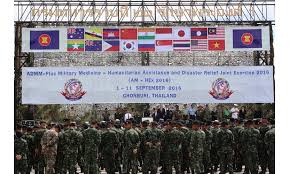SECURITY DILEMMA & ARMs RACE IN SOUTHEAST ASIAN REGION POST-COLD WAR ERA
DOI:
https://doi.org/10.25299/jdis.2019.vol2(01).4428Keywords:
Security Dilemma, Arms Race, Southeast Asia RegionAbstract
The security conditions in the Southeast Asian region are relatively safe, there have never been direct confrontations or head-to-head wars between countries in the region, if ever there had been a confrontation between Indonesia and Malaysia, but its not happen yet. During the cold war era, security in Southeast Asia was guaranteed by the two super power country, which are United States of America and Soviet Union. Some sort of bias think occur in this region, when the cold war ends European countries are committed to reducing their military budget, and the opposite is true in Southeast Asia. After the end of the cold war and the absence of security guarantees from the two countries, Southeast Asian countries began aggressively increasing their military budgets and increasing their defense force capabilities so that the Security Dilemma and Arms Race happen in this region. In particular, Indonesia has experienced an increase in the military budget from year to year, starting from 2007 Rp. 32 T to 2017 108 T. The increasing of military budget also occurs in all Southeast Asian countries, and this is clear evidence of the Security Dilemma and Arms Race in the Southeast Asian region. The research method used is descriptive qualitative research by describing all the phenomena of the research problem empirically. This study aims to explain and analyze the dynamics of Security Dilemma and Arms Race that happen in Southeast Asia, as well as Indonesia's involvement in this phenomenon, thereby increasing the defense budget each year.
Downloads
References
Bakrie, Connie R. 2007.PertahananNegara dan Postur TNI Ideal , Jakarta: Yayasan Obor Indonesia.
Muhaimin, Yahya A. 2008.Bambu Runcing dan Mesiu: Masalah Kebijakan Pembinaan Pertahanan Indonesia, Yogykarta: Tiara Wacana.
Perwita, Anak Agung Banyu, et.al. 2013.Pengantar Kajian Strategis, Yogyakarta: Graha Ilmu.
Saad, Mohammed. 2000.Development Through Technology Transfer – New Organizational and Cultural Undestanding. Bristol: Intellect.
Sloan, Elinor. 2008.Military Transformation and Modern Warfare: A Reference Handbook, Westport: Preager Security International.
Burchill, Scott. (2001). Realism and Neo-realism dalam Scott Burchill et. al., “Theories of International Relations”. New York: Palgrave, [pp. 70-102].
Dunne, Tim & Brian C. Schmidt. (2001). Realism dalam John Baylis and Steve Smith (eds.), “The Globalization of World Politics”. Oxford, [pp. 141-161].
Jackson, Robert & Georg Sorensen. (1999). Introduction to International Relations. Oxford University Press, [pp.87-138].
Rachmawati, Iva. (2012). Memahami Perkembangan Studi Hubungan Internasional. Yogyakarta: Aswaja Pressindo.
Hayward, Keith. 2002. “The Globalization of Defence Industries”, Survival, Vol.42. No.2, 1.
Kina Media Ekuitas Produk Indonesia, “Disahkannya UU Industri PertahananTonggak Bangkitnya Industri Pertahanan Lokal” Edisi 2 Tahun 2012.
Lind, William S, et.al.. 1989. The Changing Face of War: Into the Fourth Generation, Marine Corps Gazzete,Vol. 73, No. 10, 22.
Subekti, 2012.“Modernisasi Alutsista TNI AD untuk Mencapai Kekuatan Pokok Minimum”, Yudhagama,Vol.32, No. 1, 21
Desch, Michael C. 1998. “Culture Clash: Assessing the Importance of Ideas in Security Studies” dalam International Security 23:1.
Emmers, Ralf. 1999. “The De-escalation of the Spratly Dispute in Sino-Southeast Asian Relations” dalam IDSS Working Paper Series Agustus 1999.
Guan, Ang Cheng. 1999. “The South China Sea Dispute Revisited” dalam IDSS Working Paper Series Agustus 1999.
Jervis, Robert. 1978. “Cooperation Under the Security Dilemma” dalam World Politics, Vol. 30, No. 2. (Jan., 1978).
Keling, Mohamad Faisol Keling, Md. Shukri Shuib, dan Mohd Na’eim Ajis. 2009. “The Impact of Singapore’s Military Development on Malaysia’s Security” dalam Journal of politics and law Vol. 2, No. 2 (Juni 2009).
Poole, Avery D. H. 2007. “Cooperation in Contention: The Evolution of ASEAN Norms” dalam YCISS Working Paper No. 44, Januari 2007.
Powell, Robert. 1991. “Absolute and Relative Gains in International Relations Theory” dalam The American Political Science Review, Vol. 85, No. 4 (Dec., 1991).
Veeramalla Anjaiah, “China’s SCS claim threatens RI sovereignty”, The Jakarta Post,
“Anggaran Militer China Naik 12,2 Persen”, Kompas,
“Sinyal Perlombaan Senjata di Asia”, Koran Tempo,
"ASEAN mengemukakan keprihatinan atas zona maritim baru China”, http:/ / apdforum.com/ id/ article/ rmiap/ articles/ online/ features/ 2014/ 01/ 30/ asean-china-maritime,
“India Importir Senjata Utama Dunia”, Republika Online, 17 Maret 2014. http:/ / www.republika.co.id/ berita/ internasional/global/14/03/17/n2kuoa- india-importir-senjata-utama-dunia,
SIPRI Yearbook 2013, http:/ / www.sipri. org/ yearbook/ 2013, diakses tanggal 20 Maret2014.
“South Asia and Gulf lead rising trend in arms imports, Russian exports grow, says SIPRI”, http:/ / www.sipri.org/ media/ pressreleases/2014/AT_march_2014,







